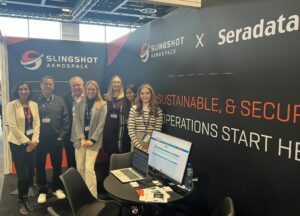David Todd, Seradata’s Head of Space Content, reports on the UK Space Conference, a biennial event held in the UK since 2007. This year’s venue for the three-day event was the International Convention Centre in Belfast, Northern Ireland.
You can always tell how important a conference is by the number of media correspondents that turn up. In this respect, the UK Space Conference was not very important at all. There were few journalists and few press announcements, and those that there were involved relatively paltry amounts – whatever the UK government or UK Space Agency spin says. Nevertheless, whatever the conference, hosted in Belfast, lacked in newsworthiness it made up for by providing a key venue for the UK Space industry as a whole to meet up. This is invaluable: not only does it mean reconnecting with old friends and colleagues, it is usually at these side meetings that much business is done.
The Conference Venue and the ‘censorious’ Slido question system

UK Space Conference; the venue was the ICC Belfast. Courtesy: Seradata/David Todd
The International Convention Centre (ICC) venue is close to the centre of Belfast on the Farset/Lagan river – and the city centre itself is a mix of nineteenth century elegance and modern buildings. It is a nice surprise to find out how pleasant Belfast is given its history of sectarian violence in “The Troubles”. The city does play on its less troubled past and while its shipbuilding reputation does have to live down the demise of Titanic in 1912 – it was not just the iceberg’s fault – today it has a special, and much visited, exhibition in the city (where the Conference Gala dinner was held), even if it lacks the actual ship pieces and artefacts that its Las Vegas counterpart has.

The Titanic Exhibition in Belfast. Courtesy: Seradata/Farah Ghouri
The ICC’s main auditorium housed the plenary sessions and there were several smaller meeting rooms and lecture theatres for the different strand events. The corridors between the exhibition halls were narrow, making the event seem more crowded than it actually was. The food at the conference was free – and much appreciated – whether at lunch or for the main reception event late on day 2.

The Seradata team on their stand at the UK Space Conference, Belfast. Courtesy: Seradata
The ICC layout was a bit confusing. Your correspondent missed at least one lecture on the third floor because he got stuck on the second floor (you almost had to go down to go up). The toilets were clean, although one set had defective lighting.
Thinking about why the press didn’t turn up, one explanation concerns the ability to ask tough questions. While the smaller presentations had roving microphones, for the larger plenary sessions and meetings the Slido question app/system was mainly used – or should we say misused. The Slido interaction system gives the audience a way to ask questions – in text, with the most popular indicated via a thumbs-up icon voting system. Sometimes the system is used to question the audience. With respect to the questions, the most popular are shown at the top of the list with the idea that they should be the ones asked. However, session hosts sometimes used the system to ignore the harder or more specific questions, choosing either more anodyne ones or more general ones aimed at all the speakers rather than individuals. While this might have saved some embarrassment – with an open mike you can’t stop the difficult questions – in reality this censorship has no place at an open conference in a democratic country. No wonder the press avoided this UK Space Conference where hard questions cannot be asked, let alone answered.
Main Plenary: Call for space to help Earth
Aarti Holla-Maini, of UNOOSA (United Nations Office for Outer Space Affairs), called for space firms to help provide solutions to help life on Earth, such as food chains, rather than just pursue space revenues. She said there needed to be a global space tracking system for fishing and briefly panicked the audience by noting that a 2% rise in global temperatures might result in a 50% rise in the price of coffee. When asked if she thought the UN should set up a space regulatory organisation along the lines of the ICAO (International Civil Aviation Organisation), Holla-Maini was less clear, but she did note the need for a new Space treaty since the last one was over fifty years old.
While the contracts and projects announced during the conference were relatively small in terms of cash value, European Space Agency (ESA) Director General Dr Joseph Aschbacher reminded the audience that the UK is the third largest contributor to ESA, after France and Germany, and a leader in space communications. He noted that ESA was moving away from building rockets to procuring them commercially using avenues such as an open market competition for small launchers. This, he explained, would later be extended to larger launches. Aschbacher admitted that ESA was following in the steps of NASA in taking this approach. He hoped commercial spaceflight would have the “information, energy and urgency” to allow this to happen. “We really like this [competitive] environment,” said Aschbacher. Whether his European industrial colleagues agree is another matter. What effect this would have on vehicles such as Ariane 6 and Vega remains to be seen. And how would it affect ESA’s long held “Juste Retour” policy of sharing out work according to how much each nation contributed? (Editor’s note: Our two questions on these issues did not get through the Slido “censorship”).
This did not mean that ESA was out of the space construction business. Aschbacher noted that it was developing a new cargo return vehicle design that should be flying by 2028.
The ‘big’ announcements: Telespazio buys e2e, UK Space Agency funds Atlantic Constellation pathfinder and rocket training
First out of the blocks – although, technically, the announcement was made at a press conference in London a few days earlier – was Telespazio UK’s acquisition of UK space communications technology firm e2e Group. This is seen as a way for Telespazio to move into new generation satellite communications, including in deep space, and not just concentrate on ground systems. Telespazio UK is a subsidiary of Telespazio (a joint venture between Leonardo, 67%, and Thales, 33%).
Through a £3 million donation to Open Cosmos, the UK Space Agency is part funding the development of the ‘Pathfinder’ satellite. With powerful onboard artificial intelligence, the Pathfinder is a forerunner to the joint Portuguese/Spanish Atlantic Constellation of Earth and coastal monitoring programmes that the UK hopes to join. The idea of the constellation is to provide regular imaging revisits over certain locations. Open Cosmos is a start-up engineering firm based at the space campus at Harwell, Oxfordshire. The satellite built in the UK will be of the same design and launched in the same orbital plane as three others from Portugal, constituting the first batch of the constellation.
The new person in charge of UK space policy, Minister of State at the Department for Science, Innovation and Technology, Andrew Griffith, (who recently replaced George Freeman in a cabinet reshuffle), made his support known. “Earth observation will play an absolutely vital role in tackling global challenges like climate change and disaster relief, providing the data we need at speed, while supporting key UK industries like agriculture and energy,” he said. Griffith added: “By working with Open Cosmos on a new satellite and supporting our Atlantic partners, Spain and Portugal, we can harness space tech for our shared goals, while creating new skills opportunities and jobs for the future to grow the UK economy.”
It was not just in satellites that the UK Space Agency had announcements. Rocket scientists and engineers are few and far between in the UK, with most of those who worked on rocket technology in the 1960s (before the UK ended is Blue Streak and Black Arrow rocket programmes) being retired or deceased. So, to reinvigorate rocket know-how, the UK Space Agency is spending £4.9 million to create a Rocketry Research, Training and Teaching (R2T2) Hub, to deliver rocket science PhDs that support the growing UK satellite launch market.
The UK Space Agency also announced a £4 million (including £800,000 contributed by the Science and Technology Facilities Council) funding injection for 23 projects from its Enabling Technologies Programme that could boost UK leadership in new space technologies and applications around the world.
The agency has form in supporting rocket launches, having sponsored three “pathfinder” maiden launches including the failed Virgin Orbit flight from Newquay, Lockheed Martin and Orbex. While acknowledging that some launch firms had failed, e.g. Virgin Orbit, and might do so in the future, Matt Archer, Director of Launch at the UK Space Agency, was keen to bring on new rocket scientist talent. “To achieve our ambition for the UK to be Europe’s leading provider of small satellite launches by 2030, we need a ready supply of skilled launch professionals,” he said. When asked if Sutherland space port was effectively a waste of time given that Saxavord, on Unst in the Shetland Isles, was gaining many more client rocket companies, Archer noted that they would be operated differently, with Sutherland’s 12 launches per year to be used solely by Orbex, while Saxavord, designed to be more adaptable, will offer its 30 launch slots per year to a wider range of users.
On day two, it was announced that the Space Clusters Infrastructure Fund had awarded more than £47 million for 12 space projects. This will be matched with funding from the space sector. While this amount sounded large, in reality it is ‘small beer’ compared with what other nations are investing in space. Having said that, the UK does give £550 million per year in funding to ESA – its main space effort.
Cis-Lunar future was heavily discussed
More than 30 countries are planning over 100 missions that include lunar landings in the next decade, according to James Myers, Senior Vice President at Aerospace Corporation, who spoke at a panel discussion on the Lunar economy. This means that everything related to infrastructure on the surface of the Moon is of increasing importance to create what Myers called “navigational and economical lanes”. Power, communications and situational awareness will all be crucial to setting up the Lunar economy in a safe and sustainable way.
Although Aerospace Corporation is a US non-profit organisation that provides technology research and development services to the US government and commercial customers, Myers stressed the need for international partnerships, such as that which helped to create the ISS. The growing number of signatories on the Artemis Accords – around 32 at the time of writing – shows the recognition of this, even as a new space race poses other challenges, namely regulatory ones – a topic repeatedly brought up at the conference.
Dr Kathryn Hadler, Director of the European Space Resources Innovation Centre, talked about how to use the resources found on the Moon and beyond to support the whole Cis-Lunar economy. Perhaps one of the most pertinent questions posed (though not answered) was that by Professor Sir Martin Sweeting, Chairman and Founder of SSTL, who asked: who is going to make money from the Cis-Lunar economy? While no one volunteered an answer, this writer strongly suspects that one of his fellow panellists is among those vying to make a profit from the Lunar economy: Nick Shave, Managing Director of Astroscale. He focused on how in-orbit servicing will transform the industry, which has hitherto harboured a “throwaway” culture in his view. Debris removal, refuelling, refurbishment and recycling are some of the services Shave expects will be needed to maintain more activities on and around the Moon and which, undoubtedly, Astroscale will try to provide.
New space tech on the horizon and how to improve UK’s share…and reduce space debris
During the session on Earth Observation, developments such as new Lidar technology, P-Band very low frequency radar and the measurement of biomass to determine the health of forests were discussed. On-board AI was seen as a key emerging technology – even with its ethical issues – as was quantum encryption, albeit with a note that only laser communications could use it. Most of the discussions saw the need to remove space electronic circuits from space hardware and ground stations.
With respect to improving the national space capability of the UK, Alice Bunn, CEO of the Institution of Mechanical Engineers, made a powerful speech in which she called for more research and development funding. Candidly, she warned that “we don’t bring enough to the table” when it comes to bidding for international space contracts. Bunn noted that while procurement could be commercial, government funding for many space projects and development would still need to be found.
The panel on sustainability in space considered the various punishments that might be imposed on those who created debris, with fines being the most popular – as recently applied to Telesat. However, when it comes to removal of debris, practical difficulties remain. Nick Shave, of Astroscale, was left on the back foot when a pointed question was allowed through noting that his firm’s spend of £300 million had so far removed “minus 1” objects from space. Shave remained optimistic that there was a good future for his firm’s removal missions. Melissa Quinn, General Manager of Seradata, said the firm’s mother company Slingshot Aerospace was adept at tracking objects in orbit – a key to avoiding future strikes.
Military Space – with China the Spectre at the Feast and the Gaza elephant in the room
The announcement of a new geostationary orbit space situational awareness telescope, ‘Nyx Alpha’ – located in Cyprus, operated by Spaceflux and tasked by UK Space Command at RAF High Wycombe – headlined the defence section of the conference. However, many other issues were discussed. At a plenary session on security, speakers noted how space was key to assessing the risks of disasters (natural and deliberate) and might even have a role in providing warnings of them.
Kevin McLoughlin, of the DSIT Space Directorate, warned about the acute threat posed by Russia and China. The likelihood of national and international disasters, whether accidental or deliberate, was compared with the potential impact, enabling a nation to build its resilience. For example, on a severity scale of one to five (with five being the highest), a severe space weather event was rated as a four but with a high (5-25%) chance of happening. A major debris generating event was also rated as a four but with only a 1-5% chance of it occurring in any given year.
Stephen Stranghan, of the UK Space Agency, warned against using space-based solutions for redundancy and mitigation of risk. For example, in Positioning, Navigation and Timing (PNT) applications, the loss of a GPS constellation due to a space weather event might also mean that its European equivalent, Galileo, could fail. Stranghan was keen to see the venerable SOHO spacecraft replaced by VIGIL in its role as a space weather sentinel.
He noted that the government could not force space companies to increase their redundancy and resilience, even if it was often in a spacecraft operator’s interest to do so. Neither speaker could answer the question: who pays for the redundancy needed for a resilient space infrastructure, especially if need to back-up Earth’s infrastructure?
There were two main plenary sessions on defence and both covered the way space-based activity was helping Ukraine following Russia’s invasion.

Space is a topic for the Generals/and Vice Marshals at the UK Space Conference 2023. Courtesy: Seradata/David Todd
Heads of armed forces discussing military space included representatives from Canada, Australia, France and New Zealand (thanksgiving meant that US Space Force representation was largely absent). New Zealand might not have a fighter jet force any more (surely it needs one?), but even it realises that its “moat” of hundreds of miles of ocean may not be enough to stop attacks from space. Air Vice Marshal Paul Godfrey, of UK Space Command, described Russia as an obvious “bad guy” in the war in Ukraine, and he mentioning how impressed he had been with the roll-out of Starlink and other space technologies. However, inexplicably, there was NO mention of the limitations that SpaceX has put on Ukraine with regard to how its Starlink communications system can be used.
AVM Godfrey was cagier about recent events in Gaza, only mentioning the initial Hamas attack on Israel and not Israel’s retaliatory counter-attack, including the aerial bombardment of Gaza and disruption of its critical telecoms infrastructure. It remains unclear whether US or NATO space assets were used to aid Israeli targeting.
Maxar, the commercial Earth observation satellite operator, was keen to point out how effective its satellite imagery had been in correcting falsehoods spread by Russia about its invasion of Ukraine. Whether Maxar would be as keen to note inaccuracies promulgated by US or NATO allies (eg Israel, Turkey) remains to be seen (our Slido question was again blocked despite being voted No 1 by audience members).
Major Jeremy Grunert, of the US Air Force Judge Advocate corps, warned that from a legal standpoint, commercial spacecraft could be considered a legitimate target if used in a time of war.
Conclusion: a brave new world and robot waiters at the airport

Robot waiter at the Belfast International Airport. Courtesy: Seradata/David Todd
Those of us who remember the analogue world look in wonder at what is being done in space – and on Earth. The Belfast International Airport even has an airside restaurant with robot waiters working alongside humans. But we all attended Belfast to talk about space. Like a proud father, the British space industry admires the progress in space technology made by the likes of India, but there is also an element of envy and a realisation that it needs to catch up.
The UK has somehow managed to reach the cutting edge of many space technologies despite historic neglect by the UK government. That said, over the past ten years things have changed and the UK government is genuinely keen to invest in space. However, as Alice Bunn noted, to continue making good progress, even more investment is required. While the UK has become the third largest investor in ESA, it needs to spend more on its national space programme. Then the agency really will have something notable to announce at its space conference, and reporters may even come to ask questions – if moderators let them, of course.
Farah Ghouri contributed to this report








